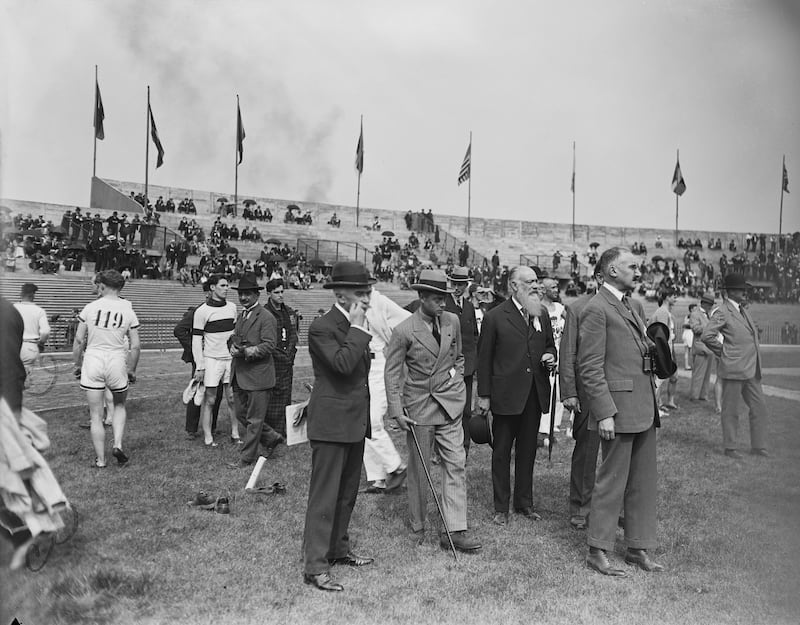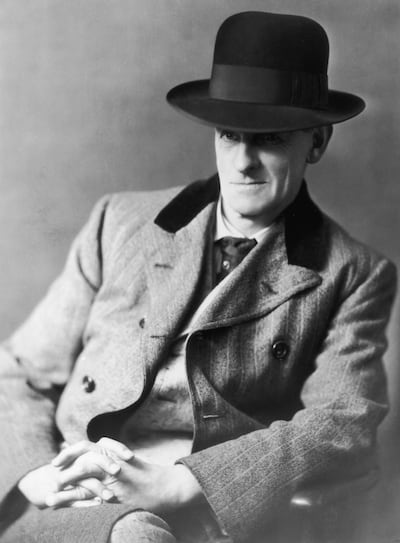This story is part of a series, The Greatest Irish Olympic Stories Never Told, which will run every Saturday in The Irish Times up to the beginning of the 2024 Olympic Games, on Friday, July 26th
It is the ultimate annoying quiz question. Who won Ireland’s first Olympic medal? Do you say Pat O’Callaghan in Amsterdam in 1928, the first Irishman in any sport to win a medal since independence? Or do you go with John McNally in Helsinki in 1952, the first medal after the establishment of the Republic? Do you pick one and not the other and turn a benign sports question into a political hot-take riot?
No. You do neither. Instead, you make the choice of all right-thinking know-it-alls and, pushing your glasses up on your nose, you declare that actually, it was Jack B Yeats. Yes, that Jack B Yeats. And no, not for sport. Not directly, at any rate.
So let’s go back. Back to Paris in 1924. Back to the Grand Palais on the Champs-Élysées where, 100 years ago next month, began the exhibition to choose the Olympic champion in painting. Not just in painting, as it happened. Five categories went to make up the broad sweep of “Les Arts” – painting, literature, architecture, music and sculpture.

[ The modern Olympic Games is far from what its founder had in mindOpens in new window ]
Now. Quite where all that fits into the whole Citius, Altius, Fortius deal is obviously a question worth asking. It all goes back to the foundation of the modern Olympics and the dubious figure of Pierre de Coubertin. Say what you will about the father of the Olympic movement but he knew what he liked (Nazis) and what he didn’t like (women’s sport). He also dabbled in a little poetry here and there, which may or may not have influenced his desire to have an arts competitions as a part of the Games when they were reinstated in 1896.
As it happens, the organising committees in the earliest iterations of the games – in Athens, Paris (1900) and St Louis – all essentially told the good Baron that they had enough to be doing putting on a sporting Olympics without stitching on a cultural one as well. But de Coubertin always had it as part of his Olympic ideal.
“There is only one difference between our Olympiads and plain sporting championships,” he said. “It is precisely the contests of art as they existed in the Olympiads of Ancient Greece, where sport exhibitions walked in equality with artistic exhibitions.” It took him until the 1912 games in Stockholm to finally get his way, whereupon the incorrigible chancer not only entered himself but won the gold medal for literature.
Spin the tape on to 1924 and by now the arts competitions were a full part of the Olympics. Entries had to be on a sporting theme and since it was being held in such a prestigious cultural capital as Paris, it’s maybe no surprise that the list of judges across the five categories became a roll-call of some of the world’s biggest names. The music competition for instance was judged by, among others, Maurice Ravel, Igor Stravinsky, Gabriel Fauré and Béla Bartók.
For what it’s worth, they must not have been overly impressed – they decided not to award a medal of any kind. The judges in the painting category were more generous, as Brendan Rooney, head curator of the National Gallery of Ireland explains.

“It was, for all intents and purposes, an art exhibition,” Rooney says. “The really interesting thing about ‘24 is the jury, which really was made up of the great and the good. Maurice Denis, John Singer-Sargant – you’re talking about really serious artists. John Lavery was in there as well, from Belfast. Now, obviously, it was spread far and wide so as to defend against any accusations of bias. But I quite like the idea of Lavery putting in a good word for Yeats. I’m sure it happened!”
By 1924, Jack B Yeats was well on the way to becoming a hugely significant figure in the art world. He was 53 years old, a friend of James Joyce and Samuel Beckett, a brother to William who had won the Nobel Prize for Literature the previous year.
“He started to paint in his 40s,” Rooney says. “Most people know him for his painting but he actually took it up relatively late. He had been an illustrator and a watercolour painter up to that – and a very successful one too. But he turned his hand to painting quite late in life and then became incredibly prolific.
“He would have been critically well-regarded at the time. This was the beginning of the swell of interest in his work. He was critically well thought-of in 1924 but commercially not as successful as he would be in subsequent years.”
Yeats had always been drawn to sport. As historian Paul Rouse says, the artist spent a lot of time in London in his 20s going to boxing matches in the East End. “Yeats captured many aspects of this world, sketching the fighters, the officials, and capturing the crowd who attended”, Rouse wrote in The Examiner in 2021.
“[In] a painting called ‘The Master of Ceremonies’, a man leaning on the red ropes of the ring, making an announcement, resplendent in evening dress and wearing white gloves. But boxers are also painted: Yeats admired them and their courage, and in short he loved their sport.”
Over his career, paintings by Yeats featured all manner of sporting scenes. Jockeys and horses, cricket players and fishermen, hurlers and shooters. Some in the foreground, some as barely perceptible details out the back. And his most celebrated – and probably one of the most famous Irish paintings in history – is The Liffey Swim, which won him the Olympic silver medal in Paris in 1924.
Yeats lived in Wicklow around this period but loved to come into Dublin with his sketchbook in his pocket and to take in whatever was going on. On this day, he and his wife Cottie came in to watch the 1923 Liffey Swim. At least we presumed Cottie was with him – most analysts of the painting itself pick out the couple, he in a fedora and she beside him in a yellow hat.
The location of the painting is instantly recognisable as the north quays, in and around Bachelors Walk. O’Connell Bridge is up ahead and the swimmers are more or less halfway through their race. The route of the Liffey Swim is much the same now as it was then – beginning around the Guinness Brewery and ending at Butt Bridge, near the Customs House.
As it turned out, Yeats’s subsequent success in Paris wouldn’t be the only Olympic link to the 1923 race. The winner that year, Cecil Fagan from Blackrock, actually competed in Paris as part of the Ireland water polo team. In fact, Fagan was two-time Olympian, as the water polo team went to Amsterdam in 1928 as well.
Yeats didn’t carry on his Olympic career, presumably deciding he had done enough first time around. He entered two paintings in Paris in 1924, The Liffey Swim and Before The Start. The latter was a painting he had done in 1915 depicting jockeys just before the tapes go up. But it was The Liffey Swim – retitled “Natacion” for the purposes of the Olympic exhibition – that took the prize.
“The thing that amuses me and always has done is that no one ever asks who won the gold,” Rooney says. “But the guy who won it, Jean Jacoby, was a Luxembourg artist who lived in France most of his life. He was an altogether more pedestrian painter. Yeats was an infinitely better artist. But Jacoby won again in ‘28! He was the Michael Phelps of the scene. I wanted to get a t-shirt saying ‘Who the hell is Jean Jacoby?’”
Hang on – so you’re saying we were robbed?
“Ha! Not quite! Well, obviously, we don’t have any record of those deliberations but the fact that Jacoby won does cast the whole thing into ... well, it’s apples and oranges really. Yeats’s painting is a seriously good picture. Jacoby’s were very pedestrian studies.”

However it all broke down, The Liffey Swim took silver. It was the first Olympic Medal of the Irish Free State, founded just over a year and a half earlier. Later at the same Olympics, Oliver St John Gogarty took bronze in the literature category for his poem “Ode To The Tailteann Games”. It hasn’t had quite the same afterlife – even Gogarty himself reckoned it was “rather tripe”.
The Liffey Swim, on the other hand, has become one of the best-known pieces of Irish art in history. It was bought for £250 in 1930 by the Haverty Trust and bequeathed to the state. Later that decade, it was brought to New York for the World’s Fair exhibition. It has featured on a stamp to mark 100 years of the Liffey Swim race itself. In 1991, it adorned the front of the 01 area phone book.
For such a genuine national treasure, it’s entirely accessible too. You can walk into the National Gallery just off Merrion Square in Dublin today and see it hanging in Room 14, pretty much straight in front of you as you come through the entrance. Yeats’s silver medal is there too, displayed by the painting. He went on to enormous acclaim in artistic circles and some of his paintings have sold for millions since his death in 1957.
As for art competitions at the Olympics, they survived until 1948. They were eventually done away with because the IOC declared that since so many of the entries were by professional artists, they couldn’t live up to the Olympic ideal. This is the self-same IOC, of course, that would stoop to craven levels of abasement in the name of money over subsequent decades.
Much like a great painting, hypocrisy lives forever.
- Join us for The Irish Times Inside Politics podcast live in Belfast on April 10th
- Sign up for push alerts and have the best news, analysis and comment delivered directly to your phone
- Find The Irish Times on WhatsApp and stay up to date









